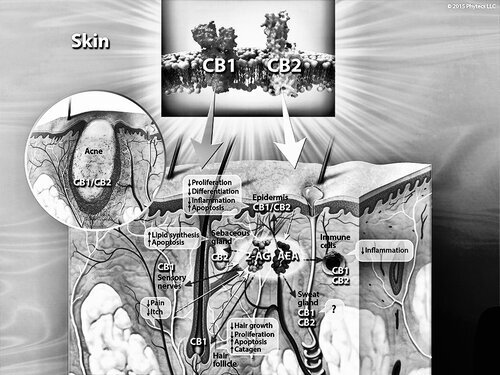
The skin is one of the largest organs of the body. Alongside its role in protecting us from various environmental challenges, it is a highly active structure in itself. The outermost part of the skin is the epidermis, which is formed by several layers of epithelial cells called keratinocytes. This compact sheet provides the body’s waterproof, physical protection barrier against UV irradiation, microbial invasion, extreme heat and cold, allergens, chemicals, and more. The next layer of the skin is the home of several “mini-organs” that we call appendages; sebaceous gland, hair follicle, and sweat gland. The skin has its own immune system that constantly protects against bacteria, viruses, allergens and other external factors. Each part of the skin is supplied by a huge, dense network of nerve fibers which recognize sensations of heat, cold, pressure, vibration, pain and itch. The skin produces endocannabinoid molecules such as anandamide (AEA) and 2-AG. Endocannabinoid molecules are synthesized by several cell types in the epidermis, hair follicles and sebaceous glands. The “classic” CB1 and CB2 receptors are present in practically all cell types of the skin. Activation of cannabinoid receptors by endocannabinoids on epidermal cells regulates normal function of the skin as a barrier. When CB1 or CB2 are engaged, these functions of epidermal cells are modified – whether through proliferation, differentiation or apoptosis – which are all important processes for the healthy physical defense of the body. Endocannabinoids also suppress inflammation in the epidermis. Modulation of ECS activity in the hair follicle may be therapeutically promising for hair growth disorders, such as unwanted hair growth or baldness. Endocannabinoid deficiency and dysregulation are thought to contribute to a wide array of human diseases and highly-prevalent conditions including acne, dry skin, inflammation and eczema.
